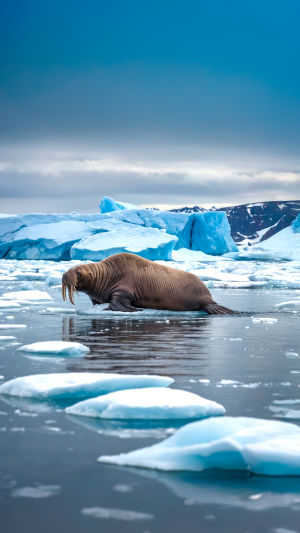Sometimes the most fascinating moments happen when we least expect them—like watching a walrus simply resting on an ice floe.
These massive Arctic mammals spend much of their day lounging on ice or coastal shores, and observing them at rest gives us a rare glimpse into their social behavior, relaxation habits, and the clever ways they adapt to survive in one of the harshest environments on Earth.
<h3>Physical Presence While Resting</h3>
When a walrus rests, its impressive size becomes even more obvious. Male walruses often weigh between 800 and 1,700 kilograms, and some exceptional individuals exceed 2,000 kilograms. Their broad, tusked faces appear almost serene as they lie on the ice.
Their flipper-like limbs may stretch out or fold beneath their bodies, and their thick layers of blubber keep them insulated against freezing temperatures. The color of their skin subtly changes depending on temperature—brownish-red on land, pale when wet—so a resting walrus on ice often glows with a soft reddish hue under the Arctic sun. Their small eyes blink slowly, and whiskers twitch slightly as they remain semi-alert, showing that even during rest, they are finely tuned to their environment.
<h3>Social Resting Behavior</h3>
Walruses are highly social animals, and resting is rarely a solitary activity. They huddle together on ice or beaches, sometimes even lying partially on top of each other for warmth. This behavior strengthens bonds within the herd and creates a sense of security.
We can observe gentle touches, nudges with whiskers, and quiet vocalizations while they rest. These subtle interactions are not random—they reinforce social hierarchies, friendships, and cooperation. Even while seemingly inactive, walruses are deeply engaged with each other, teaching us that rest can be both social and purposeful.
<h3>Daily Resting Routine</h3>
Walruses balance their resting periods carefully with foraging and swimming. After hours of diving up to 90 meters in search of shellfish or other food, they need time to recharge. On ice floes, they often sleep in short intervals, remaining partially alert to potential threats like polar bears or shifting ice.
Their resting behavior is rhythmic: they may shift positions slightly every few minutes, stretch a flipper, or move closer to companions. Observing this teaches us the importance of recovery and energy management—principles as relevant to humans as they are to Arctic giants.
<h3>Interaction With the Environment</h3>
Resting walruses are closely connected to their environment. We notice them adjusting their positions with the tides, ice movement, or sun exposure. Their tusks may rest lightly on the ice, ready to help them haul into the water if needed.
The ice provides both a safe platform and a social hub, while their thick skin and blubber layer make them resilient against freezing temperatures. By observing these interactions, we understand how walruses integrate rest into their daily survival strategy, demonstrating a harmony between body, behavior, and environment.
<h3>Learning From Observation</h3>
Watching a resting walrus is both calming and educational. Lykkers, we can see that even the largest and strongest creatures require downtime. Their relaxed poses, subtle movements, and gentle social interactions offer lessons in patience, community, and adaptability.
From a distance, we can appreciate their majesty without disturbing them, learning that survival in the Arctic is a delicate balance of rest, activity, vigilance, and social connection. These observations remind us to notice the quiet moments in life—they are often just as vital as the more dramatic ones.
<h3>Lessons From Rest</h3>
Lykkers, observing walruses resting gives us a unique window into the quieter side of Arctic life. These giants of the north demonstrate that relaxation and social connection are just as important as hunting and diving.
By studying their resting behavior, we gain insight into their resilience, intelligence, and the subtle daily rhythms that keep Arctic ecosystems thriving. Next time we imagine the frozen northern oceans, we can picture these incredible creatures lying together on ice floes, basking in the sun, and quietly showing us the value of rest and companionship.





